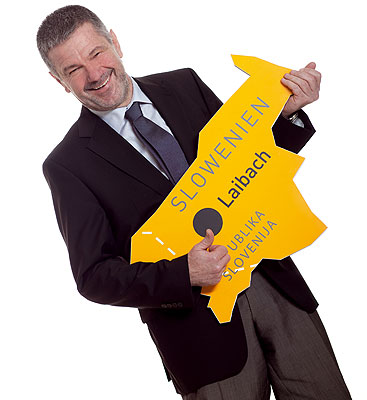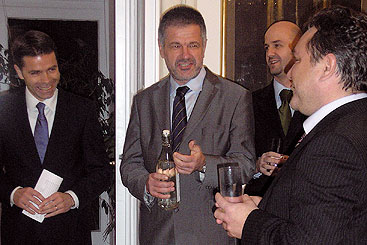Presidency 2010: Slovenia – linking the Danube to the Mediterranean Sea

Presidency 2010: Slovenia – linking the
Danube to the Mediterranean Sea
In its continuing series, Danube Watch presents portraits of the leaders whose passion and commitment help determine the future of our river basin. In this issue we speak to ICPDR President for 2010, Mitja Brecelj.

In the presence of diplomatic representatives from all Danube Basin countries, Norbert Halmo, from the Ministry of Environment of Slovakia, presented a bottle of Danube Water to Mitja Bricelj in Vienna on 14 January 2010. With this symbolic gesture, the ICPDR Presidency 2010 has been taken over by Slovenia.
Danube Watch: What are your goals for 2010?
Mitja Brecelj: The ICPDR is at a crossroads. 2010 will
be crucial for future development in the Danube region. Two central issues that are
on our agenda are the Danube
River Basin Management Plan
and the EU Danube Strategy.
Danube Watch: What is the
role of the Danube River
Basin Management Plan?
Mitja Brecelj: The Danube
River Basin Management
Plan is a roadmap to achieving
sustainable river management,
and it is crucial to bring the
Plan higher on the agenda
of the other sectors, such as
agriculture, navigation, and
the energy sector. We need
to ensure that all projects on
and along the Danube rivers
– whether infrastructure or
agriculture – follow the principles
of sustainability at the
regional level.
Furthermore, efficient adaptation to climate change can only be done based on the regional water cycle. And as the regional water cycle is the central issue of the Danube River Basin Management Plan, we have the basis for further work on this in our hands.
The current ongoing development of the EU Danube Strategy provides a unique opportunity. The ICPDR will need to ensure that the Danube River Basin Management Plan – with its goals and measures – is recognised as the environmental pillar for development in the region.
The Danube River Basin Management Plan cannot be implemented by the water managers alone, however. We need effective partnerships at the regional level – and the Danube Strategy might be a good tool to achieve this. I will personally do my best to ensure the involvement of the different players – including authorities at regional, national and international levels.

As Danube tradition dictates, the ICPDR Presidency was symbolically presented to Mitja Bricelj, Secretary of the Slovenian Ministry of Environment and Spatial Planning, in the form of a bottle of Danube Water.
Danube Watch: Slovenia is very active in promoting the
sustainable management of the Mediterranean Sea.
What are the links to the Danube in the approach?
Mitja Brecelj: Firstly, there is a natural link between
the Danube and the Mediterranean Sea – namely the
Black Sea. And as the cooperation mechanism of the
ICPDR has proved to be successful, it would be good
to also apply it to the Mediterranean Sea.
In 2005 the Mediterranean Strategy for Sustainable Development was adopted at the 14th COP of the Barcelona Convention [14th Ordinary Meeting of the Contracting Parties to the Convention for the Protection of the Marine Environment and the Coastal Region of the Mediterranean and its Protocols] in the city of Portorož in Slovenia, providing the framework for further work. It is now time to develop effective cooperation tools in the Mediterranean context.
Therefore, I organised a meeting between the management structures of the Danube and the Barcelona Convention in Postojna in 2007 to share the lessons learned – and the meeting was fruitful. Postojna was chosen as the meeting place as it is in the Slovene carstic area, where the underground waters also link the Danube and the Mediterranean Sea.
Danube Watch: The Sava river, which is so important
to Slovenia, is the first tributary of the Danube to
have its own convention. What is the value of such
sub-basin initiatives?
Mitja Brecelj: The Danube level is good for the basinwide
approach, but specific problems connected with
sub-basin characteristics can be best solved at the subbasin
level. The problems connected to the Sava can
therefore best be solved at this level: the closer one is
to the problems, the closer one is to the solutions.
Danube Watch: Thank you and all the best for your presidency!
Cv Mitja Bricelj
Mitja Bricelj was born on 4 April 1959 in Ljubljana, where he completed Gimnazija Vic High School. In 1978, he enrolled at the Faculty of Arts of the University of Ljubljana in geography and ethnology, focusing his studies on geographical environmental protection. He graduated in 1984 with his diploma work ”Degradation of the environment in the case of Industrija usnja Vrhnika (Vrhnika Leather Industry)“ for which he was granted a Prešeren Student Award. In 1991 he completed his master’s studies with a thesis entitled ”The Economic Use of the Sava River and Environmental Protection“.
He has been employed at the Ministry of the Environment and Spatial Planning of the Republic of Slovenia since 1990. During 1993–1997, he was the director of the Agency of the Republic of Slovenia for the Protection of Nature at the Ministry of the Environment and Spatial Planning. During 2007-2009, which includes also the period of Slovenian Presidency to the European Council, he was State Secretary in the Ministry of Environment and Spatial Planning.
Since 1993, he has been national coordinator for the Convention for the Protection of the Mediterranean Sea Against Pollution with its accompanying protocols (Barcelona Convention) providing a legal basis for implementing the Mediterranean Action Plan.
Mitja Bricelj has been Slovenian Head of Delegation to the ICPDR since 1995, a member of the International Sava River Basin Commission since 2005 and is now the Slovenian President of all bilateral water management commissions.






